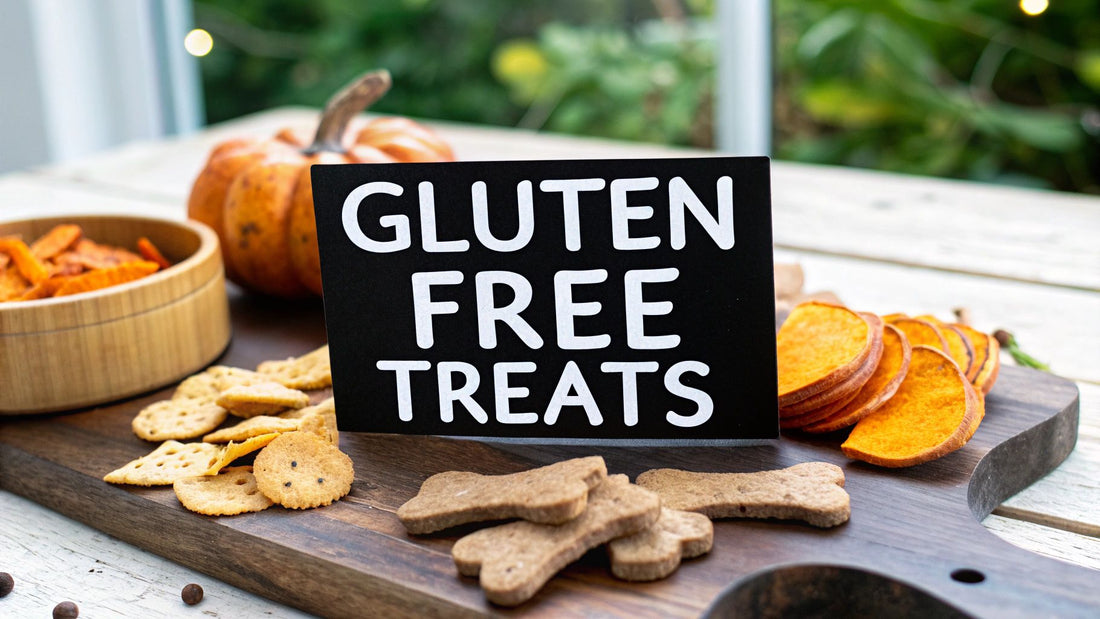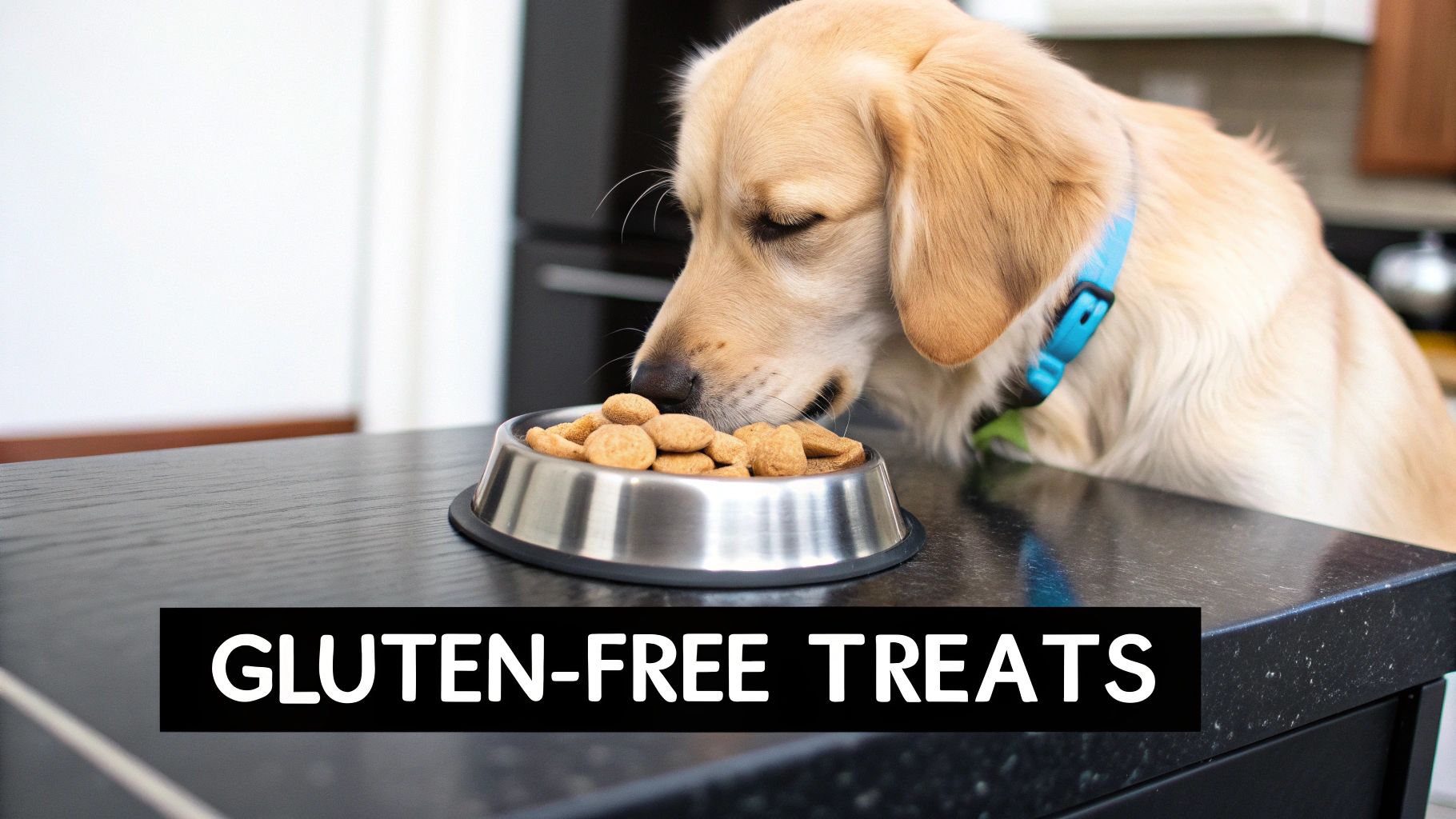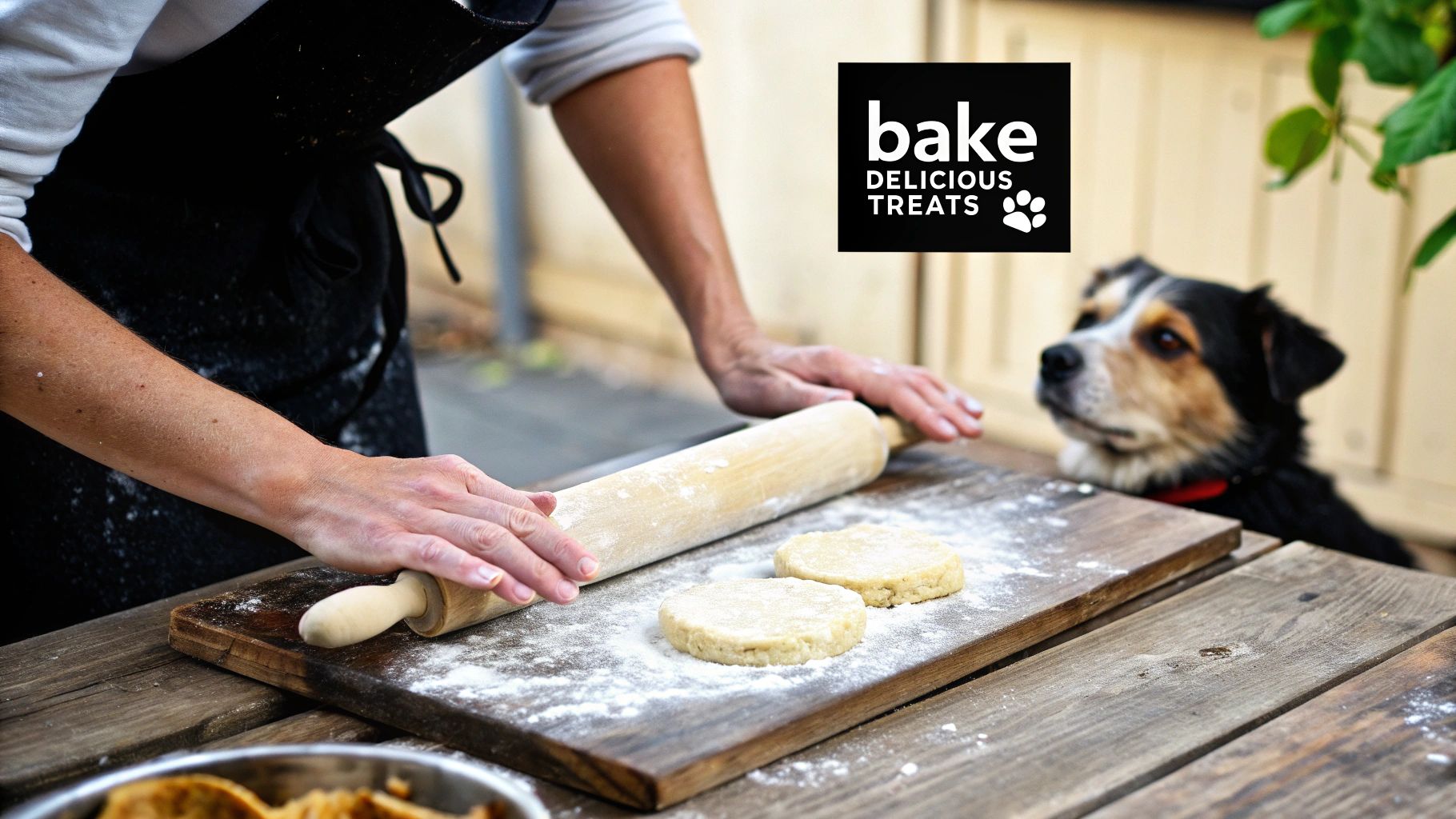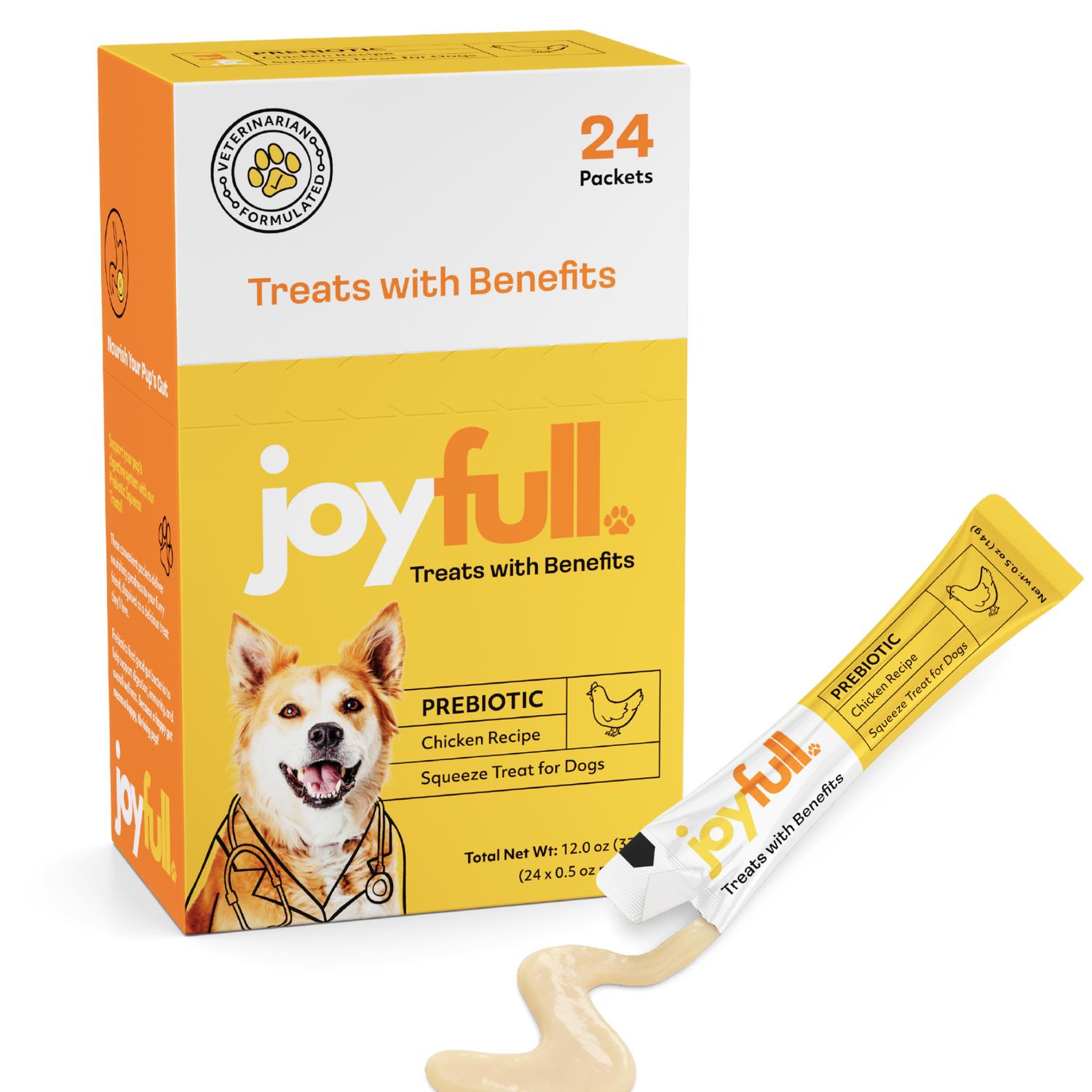
Dog Treats Gluten Free: Healthy Picks for Your Pet
Opting for gluten-free dog treats is quickly becoming a go-to choice for pet parents, especially those dealing with a dog's sensitive stomach or nagging skin problems. These treats skip the usual wheat, barley, and rye, swapping them for ingredients that are typically much easier on a dog's digestive system. It's a simple change that can make a world of difference in your furry friend's comfort and happiness.
Why Pet Owners Are Choosing Gluten-Free Treats

The idea of mindful eating isn't just for us anymore—it has completely transformed the pet food aisle. More than ever, dog owners are flipping over packages, reading ingredient lists, and looking for the same quality and transparency in their dog's food that they want for their own. This shift in mindset is what's moving gluten-free dog treats from a specialty item to a common household essential.
But what is gluten, anyway? You can think of it as the sticky, stretchy protein found in grains like wheat, barley, and rye. It's perfectly fine for most dogs, but for others, it can be the culprit behind tummy troubles or itchy skin. And that's exactly why so many people are seeking out better alternatives.
The Rise of Pet Wellness
The growing focus on pet wellness is rooted in a powerful sentiment: our pets are part of the family. This has inspired owners to look for treats that do more than just taste good—they want snacks that actively support a healthy lifestyle. This isn't just a trend; it's a fundamental change in how we view canine nutrition.
The numbers back this up. The global dog treats market is expected to explode from USD 44.2 billion in 2025 to USD 336.3 billion by 2035. That's a massive jump, and it’s largely driven by the demand for high-quality, specialized treats that meet specific dietary needs.
For many owners, going gluten-free is less about avoiding an allergen and more about providing clean, simple ingredients that are easy to digest and contribute to their dog's overall energy and well-being.
This careful approach to what we feed our pets pays off. When you choose the right snack, you're not just handing over a reward; you're making a deliberate choice that invests in your dog's long-term health. Finding the https://joyfullpet.com/blogs/news/healthiest-treats-for-dogs is a huge part of being a great pet parent, and gluten-free options are an excellent place to begin that journey.
Recognizing Signs of Gluten Sensitivity in Dogs

If your dog is feeling off, they can’t just tell you. Instead, you get clues. That persistent paw licking, the endless scratching, or those rumbly tummy troubles—it's easy to write these off as "just dog things." But sometimes, they're signals of a deeper issue, like a sensitivity to the gluten in their diet.
First, it’s helpful to understand the difference between an allergy and an intolerance. A true gluten allergy is a full-blown immune system response. It’s actually quite rare and usually pops up in specific breeds like Irish Setters. This is a serious condition that needs a vet's diagnosis.
What’s far more common is a gluten intolerance or sensitivity. It’s a lot like lactose intolerance in people; it's not a life-threatening allergy, but it definitely causes discomfort because their digestive system just can't process the gluten protein properly. This is exactly where switching to dog treats gluten free can be a game-changer.
Spotting the Telltale Signs
The signs of gluten sensitivity can be sneaky, often showing up gradually and looking a lot like other common dog problems. They usually fall into two main buckets: skin and coat issues, and digestive upset. Learning to spot these patterns is your first real step toward getting your pup some relief.
Keep an eye out for these common red flags:
- Chronic Itching and Skin Irritation: Is your dog constantly scratching, chewing, or licking their paws, groin, or ears? Gluten can trigger inflammation that shows up as itchy, dry, or flaky skin.
- Recurrent Ear Infections: If you feel like you’re always dealing with smelly, red, or yeasty ears, an underlying food sensitivity could be to blame. The inflammation from gluten creates the perfect environment for infections to take hold.
- Dull, Brittle Coat: A healthy dog’s coat should be shiny and soft. If your dog's fur looks lackluster or they're shedding way more than usual (outside of normal seasonal changes), their diet might be the problem.
- Digestive Problems: This is a big one. Things like loose stools, excessive gas, occasional vomiting, or even constipation are clear signs that something in their food isn't sitting right.
Remember, these symptoms are your dog's primary way of communicating. A simple dietary adjustment, like introducing high-quality gluten free dog treats, can often alleviate these persistent issues and restore their comfort.
Taking Action with Your Vet
Noticing these signs is a fantastic start, but you don't want to play guessing games with your dog's health. Your veterinarian is your best partner here. Before you overhaul their diet, schedule a visit to talk through what you've seen. Your notes on symptoms will help your vet rule out other health problems and decide if a food elimination trial is the best path forward.
This kind of awareness from pet owners is making waves in the pet food world. The global gluten-free dog food market was valued at an impressive USD 6.85 billion in 2024 and is expected to soar to USD 16.8 billion by 2035. That explosive growth shows just how many people are turning to specialized diets to improve their pets' lives. You can read more about the trends in the gluten-free dog food market to see just how big this movement has become.
How to Read Gluten-Free Treat Labels
Walking down the pet food aisle can be overwhelming. The front of the bag is covered in flashy marketing claims, but the real story is always on the back, in the ingredient list. Learning to read these labels is a game-changer. It helps you cut through the noise and feel confident about what you're giving your dog.
Think of it this way: you’re not trying to memorize every single ingredient. You just need to know what to look for and, just as importantly, what to avoid. For a more comprehensive look at this, our guide on how to read dog food labels goes into even greater detail.
What to Look For on the Label
When you flip that bag over, you want to see a list of whole-food ingredients you can actually recognize. The best gluten-free treats are built on a simple foundation of things that are naturally nutritious and easy for your dog to digest.
Keep an eye out for these powerhouse ingredients:
- Healthy Alternative Flours: Instead of wheat, look for flours made from things like oats, rice, coconut, or chickpeas. These give the treat its structure and provide energy without the troublesome gluten.
- Nutrient-Rich Vegetables: Sweet potatoes and pumpkin are fantastic additions. They add natural sweetness, a great dose of fiber for healthy digestion, and a boost of essential vitamins.
- Lean Protein Sources: A high-quality protein source—like chicken, beef, or fish—should be one of the first things on the list. Protein is the cornerstone of your dog's health, providing the amino acids they need to stay strong.

What to Avoid on the Label
Knowing what to spot is only half the battle; knowing what to skip is crucial. Gluten can be sneaky, but the main offenders are usually pretty easy to find if you know their names.
Scan the ingredient list carefully for these common gluten-containing grains:
- Wheat (in any form, including whole wheat, wheat flour, or wheat bran)
- Barley (often listed as pearled barley or barley flour)
- Rye
It’s also important to understand the difference between "gluten-free" and "grain-free." A treat can have grains and still be perfectly safe for a sensitive dog. For example, oats and rice are grains, but they don't contain gluten. So, while all grain-free treats are gluten-free, not all gluten-free treats are grain-free.
When you're choosing a treat, distinguishing between gluten grains and safe alternatives is the most important step.
Gluten-Containing Grains vs Safe Gluten-Free Alternatives
| Avoid These Gluten Grains | Look For These Healthy Alternatives | Primary Benefit |
|---|---|---|
| Wheat (all forms) | Oats / Oatmeal | Excellent source of soluble fiber, which aids digestion. |
| Barley | Brown Rice | A gentle, easily digestible carbohydrate for sustained energy. |
| Rye | Chickpeas / Garbanzo Beans | Packed with plant-based protein and fiber. |
| Triticale | Sweet Potatoes | A nutrient-dense carb loaded with vitamins and antioxidants. |
Knowing these simple swaps makes navigating the treat aisle so much easier and ensures you're picking something that will help your dog feel their best.
The Health Benefits of a Gluten-Free Diet

Switching to dog treats gluten free can make a world of difference for your pup, especially if they have a hidden sensitivity. The payoff isn't just some abstract health concept; it’s something you can often see and feel in your dog's day-to-day happiness. It's less about just cutting out one ingredient and more about nurturing a healthier, more comfortable system from the inside out.
One of the first things owners often notice is a huge improvement in digestion. Imagine gluten as a tough, complex food that some dogs' bodies just aren't built to handle. When they can't break it down properly, it can stir up inflammation and discomfort, leading to a gassy, bloated dog and unpredictable bathroom trips.
When you take that tricky ingredient out of the equation, their digestive system can finally catch a break and function as it should. This usually means more consistent, solid stools, less gas, and a much happier pup after treat time.
Healthier Skin and a Shinier Coat
You might not immediately connect digestion to your dog's fur, but they are absolutely linked. The chronic, low-grade inflammation caused by a gluten sensitivity often shows up on the outside. We’re talking about incessant scratching, painful hot spots, and a coat that just looks dull and dry. It's a miserable cycle for everyone.
By cutting out gluten, you help dial down that internal inflammation. As their system calms down, you'll likely see a major drop in all that scratching and irritation. This gives their skin a chance to heal, setting the stage for that soft, glossy coat to grow back in.
It's amazing how often a simple diet change is the missing piece of the puzzle to stop that constant itch.
A dog’s outward appearance is often a direct reflection of their internal health. A shiny coat and clear skin are strong indicators that their diet is providing the right nutrients without causing internal stress or inflammation.
A Boost in Energy and Vitality
Think about it: if your dog's body is constantly fighting off inflammation or struggling with digestion, it’s using up a ton of energy. That can leave them feeling sluggish, less excited for playtime, and pooped out after a short walk. It’s not that they're being lazy—their body is just completely bogged down.
Once that inflammatory trigger is gone, their body can put that energy toward fun things, like chasing a ball or greeting you at the door. So many owners tell us they see a real spike in their dog’s energy, playfulness, and overall spark after going gluten-free.
Seeing that renewed zest for life is easily one of the best rewards. It’s the clearest sign you’ve made a choice that’s helping your dog feel fantastic.
Your Guide to Picking the Perfect Treats
Walking down the dog food aisle can feel a bit overwhelming, right? But choosing the right dog treats gluten free doesn't have to be a chore. Think of it less like a test and more like being a detective for your dog's health. The secret is to ignore the flashy marketing on the front of the bag and flip it over to read the ingredient list. That’s where the truth lies.
First things first, look at the very top of that list. You want to see a high-quality, real protein source—like chicken, beef, or salmon—listed as the number one or two ingredient. This is a dead giveaway that the treat is built around real nutrition, not just cheap fillers designed to bulk it up.
Next, keep your eyes peeled for whole-food ingredients you actually recognize. It’s a lot like when you're shopping for yourself; you feel better buying things with simple, natural ingredients. In a dog treat, this means seeing things like sweet potatoes, pumpkin, peas, and carrots. These ingredients deliver a natural boost of vitamins, minerals, and fiber.
A Quick Selection Checklist
To make things even easier, here’s a quick mental checklist you can run through while you're standing in the aisle, comparing bags. A top-notch gluten-free treat should hit all these points, giving you confidence that you’re buying a snack that's both safe and genuinely good for your pup.
- Protein First: Is real meat, poultry, or fish one of the first two ingredients?
- Whole Foods Focus: Do you see healthy, recognizable ingredients like fruits and veggies?
- No Artificial Junk: Is the list clear of artificial colors, flavors, or sketchy preservatives like BHA or BHT?
- Purposeful Form: Does the treat's size and texture fit your needs? Think small and soft for training versus hard and crunchy for dental health.
Choosing a treat is an investment in your dog’s well-being. Prioritizing simple, whole ingredients ensures you’re providing a reward that nourishes their body instead of just satisfying a craving.
Match the Treat to the Occasion
Remember, not all treats serve the same purpose. What you’re doing with your dog should influence the kind of treat you grab.
If you're in the middle of a training session, you'll need something small, soft, and low in calories so you can reward them frequently without overdoing it. But if you’re looking to help clean their teeth, a tougher, more abrasive chew is a much better choice. And for those just-because-I-love-you moments? Go for that special, high-value reward that makes their eyes light up.
Introducing New Treats Safely
Anytime you bring home a new snack for your dog, it’s smart to take it slow. Start by giving them just one or two of the new treats, then wait a full 24 hours to watch for any signs of an upset stomach. This little bit of patience can help you catch a potential issue before it becomes a bigger problem.
Finally, you can never go wrong with a quick chat with your vet. They have the inside scoop on your dog’s specific health profile and can give you personalized advice. A simple check-in can provide that extra peace of mind, confirming you’re making a fantastic choice for your best friend.
Easy Homemade Gluten-Free Dog Treat Recipes
There’s something special about baking for your dog. When you make treats at home, you’re in the driver’s seat—you control every last ingredient. This means no mystery fillers, no artificial junk, and no allergens that could give your dog trouble. It’s a rewarding way to ensure your pup gets the very best.
The secret to a great homemade treat? It all starts with the flour. Ditching the traditional wheat flour for a gluten-free alternative is often much easier on a dog’s digestive system.
Here are a few of my favorite go-to flours:
- Oat Flour: This is a fantastic source of soluble fiber, which really helps with digestion. Pro tip: you can easily make your own by blitzing some rolled oats in a blender until they’re a fine powder.
- Coconut Flour: While it's packed with healthy fats and fiber, coconut flour is incredibly absorbent. You'll need to add a bit more liquid than you think to get the right consistency.
- Chickpea Flour: Looking for a protein boost? Chickpea flour is your answer. It adds a solid dose of plant-based protein and fiber to any recipe.
Once you have your flour, you're ready to get baking! If you're looking for more ideas, we've put together a collection of our favorite homemade dog treat recipes that your dog will absolutely adore.
Pumpkin and Peanut Butter Biscuits
This one's a classic for a reason. I haven't met a dog yet who doesn't go wild for the pumpkin and peanut butter combo. This recipe is super straightforward and makes a big batch of crunchy, wholesome biscuits.
What You'll Need:
- 2 ½ cups oat flour (or another gluten-free flour)
- 1 cup pumpkin puree (make sure it’s 100% pure pumpkin, not the sugary pie filling!)
- ½ cup creamy peanut butter (critically important: check the label to ensure it does not contain xylitol)
- 2 large eggs
- ½ teaspoon ground cinnamon
How to Make Them:
- First things first, preheat your oven to 350°F (175°C) and line a baking sheet with parchment paper.
- In a big bowl, whisk together the pumpkin puree, peanut butter, and eggs until they’re nice and smooth.
- Slowly mix in the oat flour and cinnamon. Keep mixing until a stiff dough starts to form.
- Dust a clean surface with a little flour and roll the dough out until it’s about ¼-inch thick.
- Grab your favorite cookie cutters, cut out some fun shapes, and arrange them on your baking sheet.
- Bake for 20-25 minutes, or until the edges are just starting to turn golden brown. For an extra crunchy treat, turn off the oven and let the biscuits cool down inside.
Frozen Berry and Yogurt Bites
On a hot day, nothing beats a cool treat. These frozen bites are unbelievably easy, require zero baking, and are full of fruity goodness and probiotics.
What You'll Need:
- 1 cup plain, unsweetened Greek yogurt
- ½ cup mixed berries (blueberries and strawberries are always a hit)
- 1 tablespoon of water (only if you need it to help with blending)
How to Make Them:
- Toss the yogurt and berries into a blender.
- Blend away until the mixture is completely smooth. If it seems a little too thick, add a small splash of water.
- Carefully pour the mixture into an ice cube tray or some silicone molds.
- Pop them in the freezer for at least 4 hours, or until they're frozen solid.
- When they’re ready, just pop the bites out and watch your dog enjoy a cool, refreshing snack.
Remember, homemade treats don’t have preservatives, so you need to store them properly. The baked biscuits are good for about a week in an airtight container. The frozen bites will keep in the freezer for up to two months.
At Joyfull, we believe our pets deserve the same healthy life we do. That’s why we’re obsessed with creating formulas using clean ingredients and high-quality proteins, all scientifically reviewed by our veterinary advisor. Explore our better-for-you snacks at https://joyfullpet.com.

